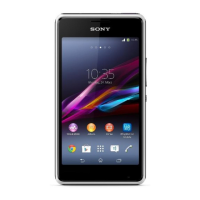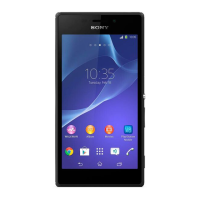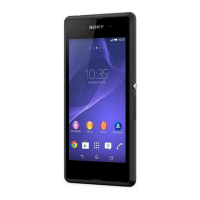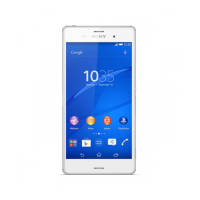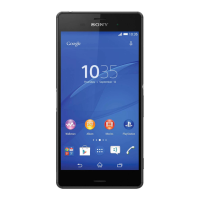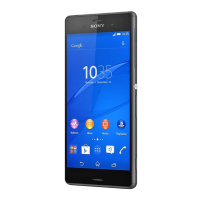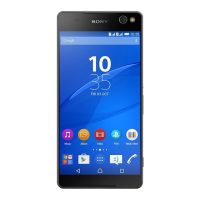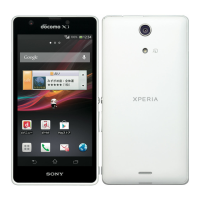Do you have a question about the Sony D2004 and is the answer not in the manual?
Identifies and describes device components and buttons.
Instructions for inserting SIM and memory cards, attaching the back cover.
Guides initial device setup and configuration.
Explains the benefits and necessity of a Google account.
Details how to connect the device to power and charge it.
Explains touch gestures like tapping, holding, pinching, and swiping.
Covers activating, locking, and unlocking the device screen.
Describes the main screen, its panes, and how to manage them.
Explains how to view, open, move, and arrange applications.
Details how to switch between apps using keys and windows.
Explains the use of small applications on the home screen.
How to organize apps and keep the home screen tidy.
Customizing the home and lock screens with wallpapers and themes.
Instructions for capturing images of the device screen.
Capturing screen images and managing status bar icons.
Explains various icons displayed in the status bar.
Brief description of core device applications.
How to download apps from the official Google store.
Instructions for enabling and downloading from unknown sources.
How to use the Google Chrome browser on the device.
Configuring settings for internet and MMS.
Connecting to and managing Wi-Fi networks.
Using the device as a USB tether or Wi-Fi hotspot.
Monitoring and managing mobile data consumption.
Manually choosing network modes like WCDMA or GSM.
Setting up and connecting to VPNs for secure access.
Syncing data like contacts, email, and calendar with online services.
Setting up and syncing with an Exchange ActiveSync account.
Syncing contacts and calendar with Outlook via PC Companion.
How to open and navigate device settings.
Adjusting volumes, ringtones, and notification sounds.
Locking and unlocking the SIM card with a PIN.
Adjusting screen brightness and touch vibration.
Setting up screen lock types like Swipe, Face Unlock, Pattern, PIN, Password.
Changing the device's display and input languages.
Setting the device's date, time, and time zone manually.
Using Clear Phase and xLOUD for better audio quality.
Using the virtual keyboard, including character entry and landscape mode.
Using voice for text input as an experimental feature.
Selecting, cutting, copying, and pasting text.
Customizing keyboard settings like languages and prediction.
Dialing numbers, using smart dial, and making international calls.
Answering, declining, and rejecting calls with messages.
Managing active calls, changing volume, and muting.
Viewing missed, received, and dialled calls, and adding contacts.
Setting up call forwarding and blocking calls.
Handling multiple calls and conducting conference calls.
Setting up and accessing voicemail service.
Making emergency calls, even when the SIM is locked or absent.
Moving contacts via computer, online accounts, or memory card.
Finding, viewing, and filtering contacts in the application.
Creating, modifying, adding pictures, and setting ringtones for contacts.
Entering ICE information for emergency access.
Marking contacts as favorites and assigning them to groups.
Sharing contact details via business card or other methods.
Linking and separating duplicate contact entries.
Exporting contacts to a memory card or SIM card.
Composing, sending, and reading text and multimedia messages.
Deleting messages, conversations, and starring important ones.
Initiating calls directly from message conversations.
Customizing notification sounds and delivery reports.
Using Hangouts for chat and video calls.
Configuring email accounts on the device.
Managing email, composing, sending, and reading messages.
Enabling a pane to view message lists and content simultaneously.
Sorting, searching, and deleting emails.
Removing accounts and changing inbox check frequency.
Using the Gmail application for email.
Moving music files from a computer to the device.
Using the WALKMAN application to play music.
Navigating the WALKMAN application's main interface.
Creating, playing, adding to, removing from, and deleting playlists.
Sharing songs, albums, and playlists via applications.
Improving audio quality with equaliser and surround sound settings.
Adding visual effects to music playback.
Identifying music tracks using the TrackID service.
Accessing music via a subscription-based online service.
Tuning into FM stations, saving favorites, and searching channels.
Saving and listening to favorite radio stations.
Adjusting mono/stereo sound and radio region.
Capturing images and videos using the device camera.
Automatically taking photos when a smile is detected.
Enabling geotagging to add location data to photos.
Overview of camera modes like Auto, Manual, and Creative Effect.
Adjusting resolution, self-timer, Smile Shutter, and HDR.
Adjusting video resolution, self-timer, Smile Shutter, and microphone.
Browsing and viewing photos/videos in the Album app.
Sharing, setting as contact/wallpaper, rotating, and deleting media.
Editing photos by cropping, applying effects, and adjusting settings.
Navigating the Album app to view online albums and share content.
Viewing geotagged photos on a map.
Playing movies and videos, changing settings, and sharing.
Moving video files from computer to device.
Getting video info, clearing info, and deleting videos.
Turning on Bluetooth, making device visible, naming, and pairing.
Sharing various file types via Bluetooth.
Connecting via USB cable for file transfer and PC Companion.
Overview of PC Companion and Media Go applications.
Transferring and managing files via USB or Mac Bridge.
Wireless file transfer setup.
Using Smart Connect to manage accessory behavior and events.
Using wallet applications for payments and storing card information.
Enabling location services for maps and camera.
Tips for optimizing GPS signal reception.
Using Maps for location tracking, traffic, and directions.
Turning on Airplane mode to disable radios and save battery.
Managing schedules, events, and integrating online calendars.
Setting alarms, managing time formats, and using stopwatch/timer.
Accessing user guides and troubleshooting via the Support app.
Checking for and installing system and application updates.
Locating the device's unique IMEI number.
Monitoring battery usage and extending battery life.
Understanding internal storage, RAM, and memory card usage.
Backing up data to a computer or SD card and restoring it.
Forcing device shutdown and performing factory data resets.
Information on responsible device disposal and recycling.
Notes on regional availability and potential charges for services.
Copyright and trademark information for the device and manual.
Identifies and describes device components and buttons.
Instructions for inserting SIM and memory cards, attaching the back cover.
Guides initial device setup and configuration.
Explains the benefits and necessity of a Google account.
Details how to connect the device to power and charge it.
Explains touch gestures like tapping, holding, pinching, and swiping.
Covers activating, locking, and unlocking the device screen.
Describes the main screen, its panes, and how to manage them.
Explains how to view, open, move, and arrange applications.
Details how to switch between apps using keys and windows.
Explains the use of small applications on the home screen.
How to organize apps and keep the home screen tidy.
Customizing the home and lock screens with wallpapers and themes.
Instructions for capturing images of the device screen.
Capturing screen images and managing status bar icons.
Explains various icons displayed in the status bar.
Brief description of core device applications.
How to download apps from the official Google store.
Instructions for enabling and downloading from unknown sources.
How to use the Google Chrome browser on the device.
Configuring settings for internet and MMS.
Connecting to and managing Wi-Fi networks.
Using the device as a USB tether or Wi-Fi hotspot.
Monitoring and managing mobile data consumption.
Manually choosing network modes like WCDMA or GSM.
Setting up and connecting to VPNs for secure access.
Syncing data like contacts, email, and calendar with online services.
Setting up and syncing with an Exchange ActiveSync account.
Syncing contacts and calendar with Outlook via PC Companion.
How to open and navigate device settings.
Adjusting volumes, ringtones, and notification sounds.
Locking and unlocking the SIM card with a PIN.
Adjusting screen brightness and touch vibration.
Setting up screen lock types like Swipe, Face Unlock, Pattern, PIN, Password.
Changing the device's display and input languages.
Setting the device's date, time, and time zone manually.
Using Clear Phase and xLOUD for better audio quality.
Using the virtual keyboard, including character entry and landscape mode.
Using voice for text input as an experimental feature.
Selecting, cutting, copying, and pasting text.
Customizing keyboard settings like languages and prediction.
Dialing numbers, using smart dial, and making international calls.
Answering, declining, and rejecting calls with messages.
Managing active calls, changing volume, and muting.
Viewing missed, received, and dialled calls, and adding contacts.
Setting up call forwarding and blocking calls.
Handling multiple calls and conducting conference calls.
Setting up and accessing voicemail service.
Making emergency calls, even when the SIM is locked or absent.
Moving contacts via computer, online accounts, or memory card.
Finding, viewing, and filtering contacts in the application.
Creating, modifying, adding pictures, and setting ringtones for contacts.
Entering ICE information for emergency access.
Marking contacts as favorites and assigning them to groups.
Sharing contact details via business card or other methods.
Linking and separating duplicate contact entries.
Exporting contacts to a memory card or SIM card.
Composing, sending, and reading text and multimedia messages.
Deleting messages, conversations, and starring important ones.
Initiating calls directly from message conversations.
Customizing notification sounds and delivery reports.
Using Hangouts for chat and video calls.
Configuring email accounts on the device.
Managing email, composing, sending, and reading messages.
Enabling a pane to view message lists and content simultaneously.
Sorting, searching, and deleting emails.
Removing accounts and changing inbox check frequency.
Using the Gmail application for email.
Moving music files from a computer to the device.
Using the WALKMAN application to play music.
Navigating the WALKMAN application's main interface.
Creating, playing, adding to, removing from, and deleting playlists.
Sharing songs, albums, and playlists via applications.
Improving audio quality with equaliser and surround sound settings.
Adding visual effects to music playback.
Identifying music tracks using the TrackID service.
Accessing music via a subscription-based online service.
Tuning into FM stations, saving favorites, and searching channels.
Saving and listening to favorite radio stations.
Adjusting mono/stereo sound and radio region.
Capturing images and videos using the device camera.
Automatically taking photos when a smile is detected.
Enabling geotagging to add location data to photos.
Overview of camera modes like Auto, Manual, and Creative Effect.
Adjusting resolution, self-timer, Smile Shutter, and HDR.
Adjusting video resolution, self-timer, Smile Shutter, and microphone.
Browsing and viewing photos/videos in the Album app.
Sharing, setting as contact/wallpaper, rotating, and deleting media.
Editing photos by cropping, applying effects, and adjusting settings.
Navigating the Album app to view online albums and share content.
Viewing geotagged photos on a map.
Playing movies and videos, changing settings, and sharing.
Moving video files from computer to device.
Getting video info, clearing info, and deleting videos.
Turning on Bluetooth, making device visible, naming, and pairing.
Sharing various file types via Bluetooth.
Connecting via USB cable for file transfer and PC Companion.
Overview of PC Companion and Media Go applications.
Transferring and managing files via USB or Mac Bridge.
Wireless file transfer setup.
Using Smart Connect to manage accessory behavior and events.
Using wallet applications for payments and storing card information.
Enabling location services for maps and camera.
Tips for optimizing GPS signal reception.
Using Maps for location tracking, traffic, and directions.
Turning on Airplane mode to disable radios and save battery.
Managing schedules, events, and integrating online calendars.
Setting alarms, managing time formats, and using stopwatch/timer.
Accessing user guides and troubleshooting via the Support app.
Checking for and installing system and application updates.
Locating the device's unique IMEI number.
Monitoring battery usage and extending battery life.
Understanding internal storage, RAM, and memory card usage.
Backing up data to a computer or SD card and restoring it.
Forcing device shutdown and performing factory data resets.
Information on responsible device disposal and recycling.
Notes on regional availability and potential charges for services.
Copyright and trademark information for the device and manual.
| Model | D2004 |
|---|---|
| Category | Cell Phone |
| Display Type | TFT capacitive touchscreen, 16M colors |
| OS | Android 4.3 (Jelly Bean) |
| Loudspeaker | Yes |
| 3.5mm jack | Yes |
| USB | microUSB 2.0 |
| Network | GSM / HSPA |
| Card slot | microSD, up to 32 GB |
| RAM | 1 GB |
| WLAN | Wi-Fi 802.11 b/g/n, hotspot |
| Bluetooth | 4.0, A2DP |
| GPS | Yes, with A-GPS |
| Radio | FM radio |
| Sensors | Accelerometer, proximity |
| Stand-by | Up to 588 h (3G) |
| Colors | Black, White |
